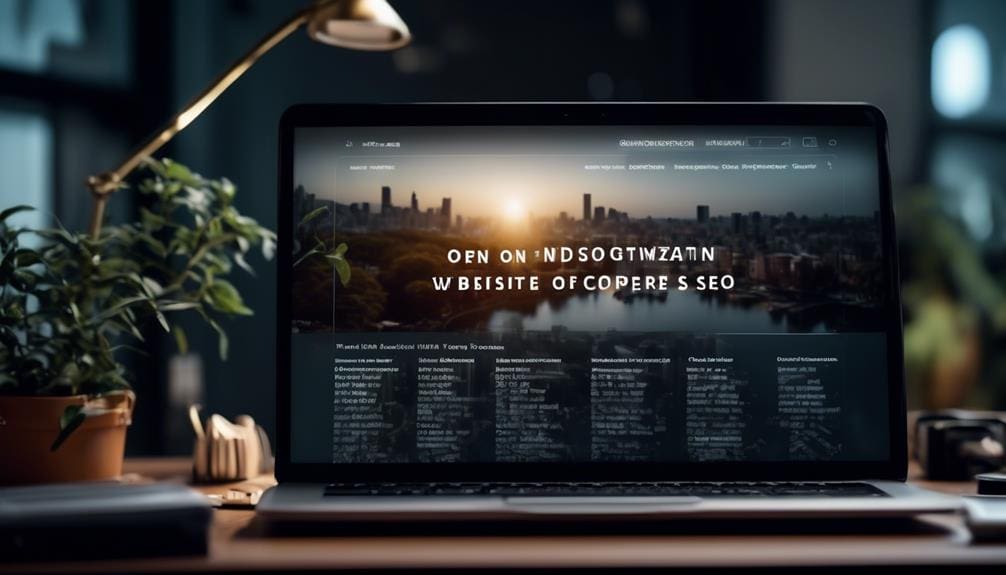The Essential Guide to On-Page SEO: Boosting Your Site's Search Rank
Are you tired of your website not showing up on the first page of search results, no matter how hard you try? Implementing on-page SEO techniques could be the missing piece to boost your site's visibility and attract more organic traffic.
Understanding the intricacies of optimizing your website's on-page elements is crucial for enhancing your search engine rankings. From keyword research strategies to mobile-friendly design factors, each aspect plays a vital role in elevating your site's online presence.
Stay tuned to discover actionable insights that can help you navigate the complexities of on-page SEO and propel your website towards the top of search engine results.
Key Takeaways
- Conduct competitive analysis for valuable keywords
- Craft compelling and keyword-rich title tags for search ranking impact
- Utilize WebP for image compression to enhance site performance
- Strategic keyword placement within content for improved SEO
Importance of On-Page SEO

Understanding the significance of on-page SEO is crucial for enhancing your website's visibility and ranking on search engine results pages. By focusing on on-page SEO benefits, you can directly impact how search engines perceive and rank your site. Optimizing user experience plays a pivotal role in on-page SEO, ensuring that visitors have a seamless and engaging journey on your website. From relevant and high-quality content to strategic keyword placement and meta tags, every aspect of on-page optimization contributes to a better user experience.
When you prioritize on-page SEO, you not only make it easier for search engines to crawl and index your site but also provide value to your audience. By optimizing user experience, you create a more accessible and user-friendly website that keeps visitors engaged and encourages them to explore further. This strategic approach not only boosts your search engine rankings but also establishes your site as a reliable source of information in your industry. Thus, investing in on-page SEO benefits both your website and your target audience.
Keyword Research Strategies
What are the most effective keyword research strategies to optimize your on-page SEO and improve your website's visibility and ranking on search engines?
Conducting competitive analysis is a crucial step in identifying the keywords that can give you a competitive edge. By analyzing your competitors' keyword strategies, you can uncover valuable insights into the keywords they're targeting successfully. This information can guide you in selecting the right keywords for your own content and help you understand the search landscape within your industry.
When delving into keyword research, don't overlook the power of long-tail keywords. While they may have lower search volumes individually, they often have higher conversion rates due to their specificity. Incorporating long-tail keywords into your content can attract more qualified traffic to your site and improve your chances of ranking higher in search results.
On-Page Content Optimization

When optimizing your on-page content, remember the crucial aspects like Title Tags, Meta Descriptions, and Keyword Placement.
Ensuring that your Title Tags are concise, relevant, and include target keywords can significantly impact your SEO efforts.
Crafting compelling Meta Descriptions that entice clicks and strategically placing keywords within your content can boost your overall search engine visibility.
Title Tags Importance
Optimize your title tags to enhance the visibility and relevance of your web pages for improved search engine performance. Title tag optimization is a critical element in SEO ranking factors, influencing how search engines understand your content. Crafting compelling and keyword-rich title tags can significantly impact your site's search ranking and click-through rates. To help you grasp the importance of title tags, consider the following emotional impact:
| Emotion | Description | Example |
|---|---|---|
| Excitement | Evoke enthusiasm | "Unleash Your Potential!" |
| Curiosity | Spark interest | "Discover the Unknown" |
| Trust | Build credibility | "Experts' Recommended" |
| Urgency | Create a sense of haste | "Limited Time Offer" |
Meta Descriptions Tips
Enhancing your web pages' visibility and relevance goes beyond title tags; now, let's focus on optimizing meta descriptions for improved on-page content performance.
When crafting meta descriptions, consider these writing tips for maximum impact. Start with a compelling sentence that entices users to click while accurately summarizing the page's content. Aim for a length of around 150-160 characters to ensure the entire description appears in search results.
By incorporating relevant keywords naturally within the meta description, you can enhance its SEO value. Avoid duplicate meta descriptions and create unique ones for each page to maximize their effectiveness.
Following these length guidelines and writing tips can significantly boost your site's search rank and drive more organic traffic.
Keyword Placement Strategy
Crafting a well-thought-out keyword placement strategy is crucial for optimizing on-page content effectively. When considering keyword placement, two key factors to focus on are content relevance and user intent. Ensuring that your keywords align with the content on your page is essential for search engines to understand the context and relevance of your website. Additionally, understanding the user intent behind the search queries can help tailor your keywords to meet the needs of your target audience effectively. By strategically placing keywords in titles, headings, meta descriptions, and throughout the content, you can improve your site's search visibility and attract more relevant traffic. Take a look at the table below for a quick reference on keyword placement strategies:
| Keyword Placement Strategies | Examples |
|---|---|
| Titles | Include primary keyword |
| Headings | Use variations of keywords |
| Meta Descriptions | Summarize content with keywords |
| Body Content | Naturally integrate keywords |
| URLs | Incorporate keywords |
Meta Tags and Descriptions

When optimizing your website's on-page SEO, focusing on meta tags and descriptions is crucial.
The title tag holds significant weight in search engine rankings while crafting compelling descriptions can improve click-through rates.
Paying attention to these elements ensures that your pages aren't only visible but also enticing to potential visitors.
Title Tag Importance
An effective title tag is essential for optimizing your website's on-page SEO and improving its search engine visibility. Tag optimization is crucial for enhancing your site's performance in search results.
Title tag best practices involve creating unique, descriptive titles that accurately represent the content on each page. Ensure your title tags are concise, relevant, and include targeted keywords to attract both search engines and users.
By following title tag best practices, you can increase the likelihood of your web pages ranking higher in search engine results pages (SERPs).
Crafting Effective Descriptions
To continue optimizing your website's on-page SEO and further enhance its search engine performance, the next critical focus is on refining your descriptions, specifically meta tags and descriptions. Crafting engaging descriptions is key to capturing users' attention and improving click-through rates.
When optimizing meta tags, ensure they accurately reflect the content on the page and contain relevant keywords to boost visibility. Additionally, when crafting descriptions, make them compelling and informative, providing a snapshot of what users can expect on your webpage.
Engaging descriptions not only entice users to click but also help search engines understand the content of your page, ultimately improving its ranking. Stay strategic in your approach to optimize these elements for maximum impact.
Internal Linking Techniques
For optimal SEO performance, strategically interlinking your website's pages can significantly enhance user experience and boost search engine visibility. Internal linking plays a crucial role in guiding both users and search engine crawlers through your site's content. By utilizing anchor text optimization and implementing effective SEO strategies, you can improve the discoverability and relevance of your web pages.
Internal Linking Techniques:
| Strategies | Benefits |
|---|---|
| Anchor Text Optimization | Increases keyword relevance |
| Link Juice Distribution | Enhances page authority |
| Strategic Link Placement | Improves site navigation efficiency |
When implementing internal linking, consider the context of each link to ensure it aligns with the content and provides value to the reader. Distributing link juice effectively across your website can boost the visibility of important pages. Carefully planning your internal linking structure can lead to a more organized site architecture, ultimately improving user experience and search engine rankings.
Image Optimization Tips

Strategically optimizing images on your website can further enhance user engagement and strengthen the overall SEO performance by complementing your internal linking strategies. When it comes to image optimization, consider the following key points:
- Image Compression Techniques
- Utilize modern image formats like WebP to reduce file sizes without compromising quality.
- Leverage tools such as TinyPNG or ShortPixel to compress images efficiently.
- Alt Text Importance
- Craft descriptive alt text that accurately represents the image content for visually impaired users and search engines.
- Incorporate relevant keywords in the alt text to improve image SEO and overall website visibility.
Mobile-Friendly Design Factors
When optimizing for mobile, ensure a responsive layout that adapts seamlessly to different screen sizes.
Mobile users value speed and performance, making it crucial to prioritize fast loading times and smooth navigation.
Consider factors like image compression and minimizing redirects to enhance the mobile user experience.
Responsive Layout Importance
Implementing a responsive layout on your website is crucial for optimizing user experience across various devices. By focusing on mobile optimization and enhancing user experience, you can significantly impact your site's search rank. Here's why responsive design is essential:
- Improved Mobile Optimization:
- Ensures your website functions seamlessly on smartphones and tablets.
- Helps in achieving higher visibility in mobile search results.
Responsive layouts adapt to different screen sizes, providing a consistent experience for users. This approach not only caters to the diverse device landscape but also aligns with search engines' preference for mobile-friendly websites. Prioritizing responsive design is a strategic move that can positively influence your site's performance and overall SEO efforts.
Speed and Performance
Responsive layout optimization not only enhances user experience but also plays a key role in improving the speed and performance of your website, particularly in relation to mobile-friendly design factors.
To further boost your site's performance, consider implementing browser caching benefits. Browser caching allows frequently accessed resources to be stored locally, reducing load times for returning visitors.
Additionally, employing minifying code techniques can help streamline your website by removing unnecessary characters without affecting functionality. By minimizing file sizes, your site can load quicker, providing a smoother and more efficient user experience.
These optimizations not only benefit your visitors but also contribute to better search engine rankings, making your site more competitive in the online landscape.
Page Loading Speed Optimization

Optimizing your page loading speed is a crucial aspect of enhancing user experience and boosting your site's search engine performance. To achieve optimal loading times, consider implementing the following strategies:
- Browser Caching Benefits:
- Utilize browser caching to store static resources locally on your visitors' devices, reducing load times for returning users.
- Leverage cache-control headers to specify how long browsers should cache your content, enhancing speed and performance.
- Image Compression Techniques:
- Employ modern image formats like WebP to reduce file sizes without compromising quality, speeding up load times.
- Use tools such as Kraken.io or TinyPNG to compress images effectively while maintaining visual appeal.
URL Structure Best Practices
After optimizing your page loading speed through techniques like browser caching and image compression, the next critical step is structuring your URLs according to best practices for improved search engine visibility and user navigation efficiency.
URL structure optimization plays a vital role in enhancing your site's SEO performance. When creating URLs, ensure they're concise, descriptive, and contain relevant keywords to make them SEO friendly. A well-structured URL not only helps search engines understand the content of your page but also provides users with a clear indication of what to expect.
Consider organizing your URLs logically, using hyphens to separate words, and avoiding special characters or IDs whenever possible. Additionally, incorporating your target keywords in the URL can further boost your search engine rankings.
Schema Markup Implementation

Implementing Schema Markup on your website can significantly enhance your search engine visibility and improve the understanding of your content by both users and search engines. By incorporating structured data into your HTML, you provide search engines with explicit clues about the meaning and context of your content. This can lead to the creation of rich snippets in search results, which can increase the click-through rate to your site.
- Benefits of Rich Snippets Implementation
- Increased visibility in search results
- Enhanced user engagement due to more informative snippets
- Local SEO Optimization and Business Listings
- Utilize schema markup to highlight essential business information
- Improve local search presence by providing accurate details like address, phone number, and operating hours
Frequently Asked Questions
How Can I Track the Effectiveness of My On-Page SEO Efforts Over Time?
To track the effectiveness of your on-page SEO efforts over time, focus on tracking progress by analyzing data regularly. Use tools like Google Analytics and SEO software to monitor keyword rankings, organic traffic, and conversion rates.
What Are Some Common Mistakes to Avoid When Optimizing On-Page Content for Seo?
When optimizing on-page content for SEO, watch out for common mistakes like excessive keyword density. Ensure readability for users. Optimize images and utilize internal linking for better site structure and user experience. These steps can boost your search rank.
Are There Any Specific Tools or Plugins That Can Help With On-Page SEO Optimization?
To enhance your on-page SEO, consider tools like Yoast SEO for keyword density analysis and internal linking suggestions. These resources can streamline optimization efforts, guiding you toward strategic content improvements that boost your site's search rank.
How Often Should I Update My Meta Tags and Descriptions for Optimal SEO Performance?
For optimal SEO performance, update your meta tags and descriptions regularly. Meta tag optimization should occur whenever there are significant changes to your content or target keywords. Description updates can have a direct impact on click-through rates and search visibility.
What Are Some Advanced On-Page SEO Techniques That Can Further Improve Search Rankings?
To further boost your search rankings, consider implementing schema markup for rich snippets and enhancing image optimization techniques. By strategically utilizing these advanced on-page SEO tactics, you can drive more traffic and improve your site's visibility.
Conclusion
In conclusion, mastering on-page SEO is crucial for improving your site's search rank. By strategically incorporating keyword research, optimizing content, utilizing meta tags, internal linking, mobile-friendly design, page loading speed, URL structure, and schema markup, you can enhance your site's visibility and attract more organic traffic.
Remember, attention to detail and continuous optimization are key to staying ahead in the competitive world of search engine rankings. Stay focused, stay strategic, and watch your site climb the search results ladder.







